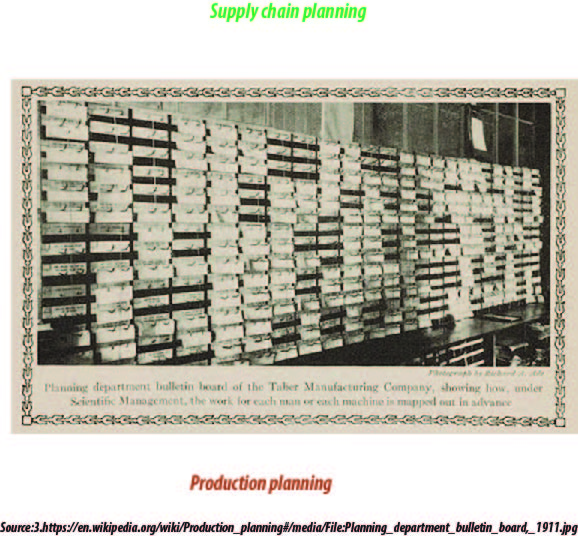### Supply Chain Planning: A Comprehensive Overview
#### Abstract
Effectively managing customer demand uncertainties is critical for optimizing production plans and quantities. The goal is to meet fluctuating customer demands while maximizing profits and minimizing production costs. Aggregate planning plays a pivotal role in determining optimal levels of capacity, production, inventory, pricing, subcontracting, and more. It involves strategic decisions about production locations, time scheduling, and sequencing. Key parameters include production rates, workforce, overtime, machine capacity, subcontracting, backlog, and inventory levels. In industries like fashion apparel, where demand is highly unpredictable, collaborative forecasting among enterprises is essential for robust supply chain planning. However, even with forecasts, customer demand often remains uncertain during production planning.
#### Keywords: Supply Chain Planning
—
### Article
#### Introduction
Supply Chain Planning (SCP) is a strategic approach to balancing the supply of goods and services with customer demand. It is a fundamental component of supply chain management, alongside supply chain execution. Aggregate planning methods are used to make decisions regarding production, outsourcing, and backlog management, ensuring efficient supply chain operations.
—
### A Company’s Supply Chain
Supply chain planning encompasses various facets of a company’s operations, including inventory management, sales, and production. Effective planning facilitates just-in-time inventory management and enhances operational transparency through tools like multi-screen dashboards. These strategies enable supply chain managers to save costs and improve efficiency.

*Figure: Supply Chain Planning*
—
### Aggregate Planning
Aggregate planning involves determining optimal levels of capacity, production, inventory, stock-outs, pricing, and subcontracting over a specific time frame. Its primary objective is to meet demand while maximizing profitability. Unlike SKU-specific decisions, aggregate planning addresses broader decision-making challenges and significantly impacts overall supply chain performance. Collaborative forecasts from various enterprises serve as critical inputs for aggregate planning, though external constraints from supply chain partners often pose challenges.
—
### Objectives of the Aggregate Planner
The aggregate planner focuses on identifying key parameters within a given timeframe, including:
– **Production Rate**: Units produced per time period.
– **Workforce**: Number of workers or production capacity required.
– **Overtime**: Additional production planned beyond regular hours.
– **Machine Capacity**: Units of machine capacity needed for production.
– **Subcontracting**: Outsourced production capacity over a specific period.
– **Backlog**: Unfulfilled demand deferred to a future period.
– **Inventory on Hand**: Inventory carried over from one period to the next.
These parameters are essential for effective aggregate production planning and ensuring supply chain efficiency.
—
### Production Planning Process
Production planning optimizes product design and manufacturing processes, initially developed for traditional manufacturing but now widely applied in software development and delivery. This process involves forecasting demand, evaluating production options, selecting the most efficient approach, monitoring progress, and adjusting plans as needed. It also accounts for resource availability and market trends to ensure seamless execution.
—
### Production Planning in the Apparel Supply Chain
In the fashion apparel industry, production planning must address demand uncertainties to minimize costs and maximize profits. This involves strategically placing production orders by location and scheduling them effectively. Given the economic significance of production planning for apparel suppliers, creating a robust plan that mitigates risks from demand forecasts is crucial. Collaborative forecasting and risk management are essential to handle the inherent uncertainties in customer demand.
—
### Conclusion
Effective supply chain planning requires aligning production capacity with demand forecasts. For instance, if an enterprise can produce and sell 10,000 units but only has supplies for 8,000 units, production must align with the lower figure. Accurate forecasting helps determine the required supply levels to maintain productivity. Enterprises can leverage past experiences, industry trends, economic forecasts, and feedback from sales and marketing teams to predict demand. By evaluating production capabilities and factoring in costs like interest on borrowed supplies, businesses can strike a balance between what they need to produce and what they can afford to produce.
—
### References
1. Ait-Alla, Abderrahim, et al. (2014). “Robust Production Planning in Fashion Apparel Industry under Demand Uncertainty via Conditional Value at Risk.” *Mathematical Problems in Engineering*, Volume 2014, Article ID 901861. [DOI Link](http://dx.doi.org/10.1155/2014/901861)
2. Johnston, Kevin. “Aggregate Planning in Supply Chain Management.” [Chron.com](https://smallbusiness.chron.com/aggregate-planning-supply-chain-management-73641.html)
3. Wikipedia. “Production Planning.” [Link](https://en.wikipedia.org/wiki/Production_planning#/media/File:Planning_department_bulletin_board,_1911.jpg)
4. YouTube. “How Supply Chain Planning Works.” [Video Link](https://youtu.be
Post Disclaimer
The information provided in our posts or blogs are for educational and informative purposes only. We do not guarantee the accuracy, completeness or suitability of the information. We do not provide financial or investment advice. Readers should always seek professional advice before making any financial or investment decisions based on the information provided in our content. We will not be held responsible for any losses, damages or consequences that may arise from relying on the information provided in our content.


